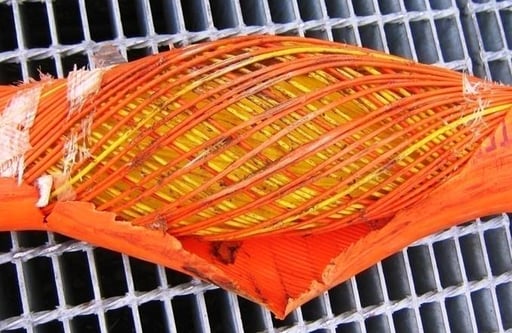To ensure that your ROV Cable lasts as long as possible and downtime is kept to a minimum, certain offshore cable standards must be considered. Two factors of great importance are the stretching and rotation of the cable. These natural forces greatly impact the cable, especially with long cables like ROV Cables.
In this blog, we explain which offshore cable standards we usually adhere to minimize damage to the cable. In addition, we give some examples of issues that can occur when the cable stretches or rotates too far.
Offshore cable standards for stretching: how much can my cable stretch?
When we talk about stretching an ROV Cable, there are strict requirements to prevent permanent deformation. These offshore cable standards for stretching vary by material, based on the stretch that will permanently deform the material in question.
Once the load is gone after stretching, the material bounces back into its original position. However, the material deforms plastically if the load is too high and cannot spring back to its old position.
The danger of permanent deformation is somewhat contained thanks to the helix used in an ROV Cable. Increasing the helix angle makes the cable more flexible. As a result, the helix allows the cable to stretch further than the elastic limits of the individual materials used in the cable. In ROV Cables, the helix absorbs the stretch up to 0.6% This means that DeRegt can handle a maximum stretch of 0.6% for ROV Cables without permanently deforming the individual components.
Consequences of stretching an ROV Cable too far
Stretching a cable is inevitable with load, and up to a certain limit, it can't do any damage. The cable will spring back to its former shape after deployment as long as the materials stay within their elastic limit. However, if the cable stretches further than the offshore cable standards prescribe, the excess length will remain once the cable is withdrawn.
But what does this mean for the ROV Cable’s lifespan?
The so-called Z-kink is a common phenomenon that occurs when overstretching an ROV Cable. This is because the excess length created when a cable is overstretched has nowhere to go, and forms a Z when retracted. The image below shows an example of such Z-kinks.
.jpg?width=602&name=image002%20(1).jpg)
Z-kinks are not only a visual defect of the cable; they can cause mechanisms in the cable to malfunction. The form of the Z-kinks indicates which type of failure mechanism is likely. It is always possible that more than one mechanism is present, in which case careful examination is required to determine all possible failure modes.
Offshore cable standards for rotation: how much can my cable rotate?
Another aspect common to offshore cable standards is cable rotation. This is because a cable will rotate under load. This also happens with smaller cables, such as yo-yos and earbuds. The cable must be "torque balanced" as much as possible to prevent damage. This means that the cable does not rotate too much under load.
The rule of thumb is that the ROV Cable should not rotate further than 3 degrees per meter under the maximum workload. This is because if the cable rotates further than 3 degrees per meter, the cable will break down faster.
Like other offshore cable standards, the limitation on rotation keeps the lifespan of an ROV Cable as high as possible while minimizing downtime.
Consequences of excessive rotation in ROV Cables
In ROV Cable design, we always try to achieve a rotation of 0 degrees per meter. This is not practically feasible, but the result of raising our own standards is that we are often well below the 3 degrees per meter mark. This is more than just a precaution. Like overstretching, too much rotation can have severe consequences for the cable.
For example, a non-torque-balanced cable can become a victim to bird caging; different layers and wires will cross each other (and in the worst-case interfere). A birdcage is caused by excessive turning of the cable, but can often be prevented by diligent inspection and proper cable design. The image below shows an example of a birdcage.

Another typical result of excessive rotation is the so-called corkscrew (see image below). This cable deformation is visible on the outside of the ROV Cable and looks like the corkscrew we know from the kitchen. In the worst case, a corkscrew can rupture the core or strength member, putting the entire subsea project at risk. Preventing deformation of the cable is therefore of great importance.

The third form of distortion that can be caused by excessive rotation is cable hockling. Excessive rotation might create a loop in the cable, just as you may have experienced with a laptop adaptor or your earbuds. For long ROV Cables that are subjected to high remote tension, the loop can cause the cable to become permanently damaged by material deformation. This process is known as hockling.
Testing for Offshore Cable Standards
To avoid the above issues, cable design must be done according to specific offshore cable standards. Therefore we always do an elongation vs workload test (to check the maximum stretch of 0.6%) and a rotation vs load test to verify that the cable does not rotate too much when loaded.
In our Webinar On-Demand, Sander van Leeuwen, R&D Manager at DeRegt, talks about these techniques and many more important considerations when developing ROV Cables. Download the recording for free here:
With all other questions about your cabling needs, you can contact my colleagues or me here. Our experts are always happy to explain offshore cable standards, create a Custom Cable Design for your project, or advise or guide you in your ROV Cable requirements.



